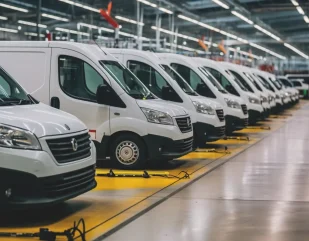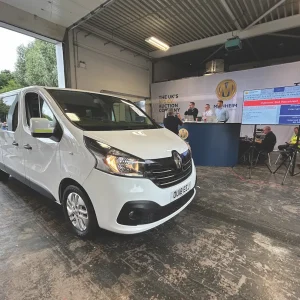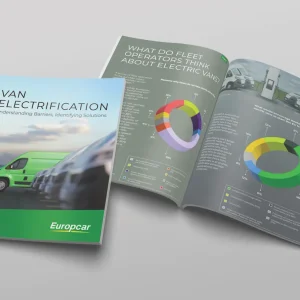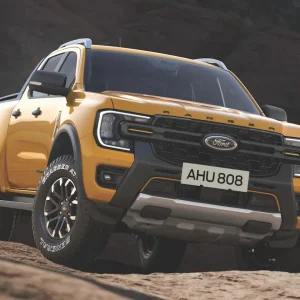
“Post-pandemic, we started seeing more people from a purchase background, so they’re used to having no flexibility around their vehicles at all.”
That’s Northgate Vehicle Hire’s sales director, Spencer Davi, on van fleets’ habits either side of Covid. While LCV operators – at least those with sizeable fleets –
often own a portion of their vehicles, Davi believes it is now common for them to acquire a chunk via long-term rental when a new project or contract comes along.
“They may have 50 vans, and they’ll have 30 of them on a long-term, three-year, fixed contract so they’ve got assurances over service delivery, cost et cetera. But they might have another 20 on short or mid-term contracts, so they’ve got that flexibility, rather than just being in the leasing camp.”
Van leasing is alive and well, but arguably the least appealing way to stock up a fleet, because it lacks the tax break of outright purchase and the noncommittal, instant availability of rental.
“A heck of a lot of van operators buy their vehicles,” explains Fleetcheck managing director, Peter Golding. “They don’t lease them, so they might hire purchase them, and there are benefits of doing this with the annual investment allowance. You can write off 100% of a diesel vehicle in its first year.”
The line between leasing and rental can blur too, because there can be overlap between their respective periods. The latter implies something a business would hire for no more than a few days – and that does happen – but two or three years at a time under the guise of long-term rental isn’t unusual.
Gemma Dickson, group sales and marketing director at Herd Group – which specialises in flexible van hire that often bleeds into the long-term – explains: “I don’t really think people understand the difference between lease, contract hire or flexi-rent, in all honesty. Most companies that run a fleet of vehicles tend to have their own portion that they’re in control of. They can run that for as long or as short a term as they like, but they have to write that down on their balance sheet. Then you tend to find they’ll have this portion in the middle which they’ll have on long term rental or leased.”
Nexus Vehicle Rental, which claims to work with 230 UK hire companies, says its average van rental period more or less quadrupled after the pandemic.
“Pre-Covid, and this excludes the one-to-two-day rentals, you were looking at anything from 30 to 50 days on average,” says chief revenue officer, Stuart Miles. “The peak post-Covid, in 2022 and 2023, was in excess of 180 days, and what we’ve started to see now is a gradual decline. We’re now looking at average rental of about 170–175 days.”
You don’t have to join too many dots to spot the macroeconomic trends. The pre- and post-pandemic rental tendencies point partly to shaky business confidence and a reluctance among fleets to add too many vehicles to their balance sheets, and partly to either the scarcity of new vehicles (which is widely acknowledged to have improved but is still not perfect) or the time elapsed between ordering a van and when it actually turns up.
Dickson says flexi rent is especially common in sectors such as rail, utilities, domestic maintenance, construction and the public sector, including the NHS.
“It’s also popular with logistics and couriers,” she says. “What you tend to find is that they’ll win a contract, and they’ll need to up-fleet quickly.”
The speed at which new contracts can drop into a business’s lap creates a need for fresh vehicles on the double. Even if a company has a hefty fleet, a new client can mean a new set of requirements, which the existing vans may not meet.
“Vehicles can become obsolete, or they’re no longer fit for purpose when new contracts come in,” adds Dickson.
“You tend to find the vehicle isn’t necessarily assigned to one specific person, which is another reason why people would flexi rent…they might tie it into a contract for three years, but it’s still a rental vehicle, so it doesn’t have to sit on your balance sheet.”
The ZEV mandate has cast its shadow across all corners of the industry and, altruistic though its zero-emission objective may be, operators, manufacturers and suppliers are acutely aware of how immediate and unrealistic this year’s target of 10% new van registrations seems, especially as the year enters its final phase.
Rental and leasing companies have the unenviable task both of procuring EVs amid an environment of uncertain residual values and convincing their customers to lease or hire them, all while bodies such as the Association of Fleet Professionals and the BVRLA point out their impracticalities in all but a minority of circumstances.
While some renters are happy to take EVs, the majority just want a familiar
diesel van, as Nexus’s Miles explains: “What we’re seeing is that there are requests for certain electric vehicles, but their [fleets’] primary focus is, ‘we need a vehicle now to get a job done’. Yes, there is a demand for [EVs], but not as much as we’d expect. I think the demand for diesel vans remains as it has for a long time.”
Fleetcheck’s Golding believes the ZEV mandate is appropriate for cars, particularly against the backdrop of low tax for fleets and company car drivers but disagrees with it for vans and believes each segment requires a separate approach.
“I think we need to look at them as totally different from electric cars. Where the problem lies is that the government has lumped them together for the ZEV mandate, and they should never have done that.
“I think what we have to have is a completely different mindset as to how electric vans are put on fleet. The durability and reliability of them is such that we
have to be looking at much longer replacement cycles.”
To that end, Nexus is looking into extending EVs by taking used examples from leasing companies and offering them via its rental platform. It’s not a new concept, as many contract hire companies operate second-life leasing at a relatively low level.
“We are having discussions about how [leasing companies] can make that vehicle earn money,” explains Miles. “If you’ve got a pool of electric vehicles coming back that you do not want to sell because you’re making residual value losses…we’re looking at how we can turn that into supply – repurposing those vehicles into the rental market.”
Small is beautiful
A glance at the SMMT’s registration figures would make you think nobody wants small vans. Sub-2.0t models have been the smallest group by sales figures for a long time, eclipsed not only by medium and large LCVs – which always take a much bigger slice of the market – but by pick-ups and even (just about) 4x4s.
The figures are more down to sluggish production than lack of demand, though, as Nexus operations director, Yvonne Palmer, explains: “There’s still a massive shortage of smaller, car-derived vans. We have seen quite a few suppliers start to bring them back onto fleets, because they are able to get them again, but we’re not back to where we were.”
“Small, diesel vans are flying out now,” adds Northgate’s Davi. “Not enough of them were built post-pandemic, so there was a bit of a crunch point…and another thing we’ve noticed is that people’s mindsets about the type of vehicle they have post-pandemic has changed.
“Some were rolling around in 4.0-metre vehicles with extra-long wheelbases, because that’s what they always had. Now, you find more businesses willing to rationalise what they’re doing – maybe they don’t need that vehicle. Maybe, instead of having 10 4.0-metre vehicles on your fleet, you only need two and you only need six L2 short wheelbases, so you’ve actually shrunk your fleet down.”
Sub-2.0t van registrations were up 40.3% year-on-year in September 2023 – by far and away the fastest-growing group by size and clearly playing catch-up – but that still left them behind every other group in volume terms.
Along with their cheap and cheerful appeal, location is another draw, according to Palmer: “Some of it comes down to geography. If you’ve ever tried to drive an extra-long wheelbase on the streets of Cornwall, it’s definitely going back with some damage on it. We know some customers struggle in particular areas, so they go for the smaller sized vans.”





